
Opabinia regalis is an extinct, stem group arthropod found in the Middle Cambrian Burgess Shale Lagerstätte of British Columbia. Opabinia was a soft-bodied animal, measuring up to 7 cm in body length, and its segmented trunk had flaps along the sides and a fan-shaped tail. The head shows unusual features: five eyes, a mouth under the head and facing backwards, and a clawed proboscis that probably passed food to the mouth. Opabinia probably lived on the seafloor, using the proboscis to seek out small, soft food. Fewer than twenty good specimens have been described; 3 specimens of Opabinia are known from the Greater Phyllopod bed, where they constitute less than 0.1% of the community.

Nectocaris is a genus of squid-like animal of controversial affinities known from the Cambrian period. The initial fossils were described from the Burgess Shale of Canada. Other similar remains possibly referrable to the genus are known from the Emu Bay Shale of Australia and Chengjiang Biota of China.
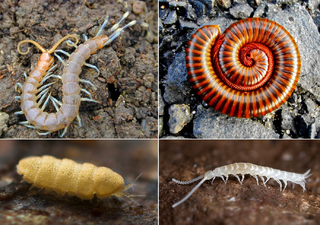
Myriapods are the members of subphylum Myriapoda, containing arthropods such as millipedes and centipedes. The group contains about 13,000 species, all of them terrestrial.

Arthropleura is a genus of massive myriapod that lived in what is now Europe and North America around 345 to 290 million years ago, from the Viséan stage of the lower Carboniferous Period to the Sakmarian stage of the lower Permian Period. It is related to millipedes, and was capable of reaching at least 2 metres in length, possibly up to over 2.5 metres, making it the largest known land arthropod of all time. Arthropleura is known from body fossils as well as trace fossils, particularly giant trackways up to 50 centimetres (20 in) wide, and potentially also large burrows. It lived in open, sparsely wooded environments near water, and was possibly amphibious.

Naraoia is a genus of small to average size marine arthropods within the family Naraoiidae, that lived from the early Cambrian to the late Silurian period. The species are characterized by a large alimentary system and sideways oriented antennas.

Fuxianhuia is a genus of Lower Cambrian fossil arthropod known from the Chengjiang fauna in China. Its purportedly primitive features have led to its playing a pivotal role in discussions about the euarthropod stem group. Nevertheless, despite being known from many specimens, disputes about its morphology, in particular its head appendages, have made it one of the most controversial of the Chengjiang taxa, and it has been discussed extensively in the context of the arthropod head problem.
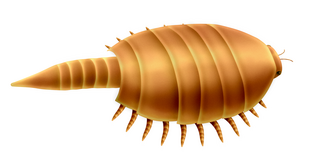
Euthycarcinoidea are an enigmatic group of extinct, possibly amphibious arthropods that ranged from Cambrian to Triassic times. Fossils are known from Europe, North America, Argentina, Australia, and Antarctica.
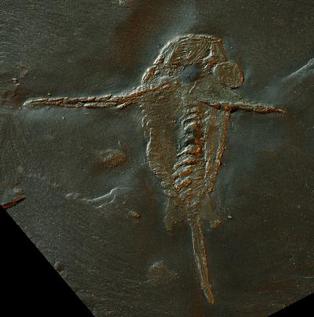
Schinderhannes bartelsi is a species of hurdiid radiodont (anomalocaridid), known from one specimen from the Lower Devonian Hunsrück Slates. Its discovery was astonishing because the latest definitive radiodonts were known only from the Early Ordovician, at least 66 million years earlier than this taxon.

Radiodonta is an extinct order of stem-group arthropods that was successful worldwide during the Cambrian period. Radiodonts are distinguished by their distinctive frontal appendages, which are morphologically diverse and were used for a variety of functions. Radiodonts were among the earliest large predators, but they also included sediment sifters and filter feeders. Some of the most famous species of radiodonts are the Cambrian taxa Anomalocaris canadensis, Hurdia victoria, Peytoia nathorsti, Titanokorys gainesi, Cambroraster falcatus and Amplectobelua symbrachiata. The later surviving members include the subfamily Aegirocassisinae from the Early Ordovician of Morocco and the Early Devonian member Schinderhannes bartelsi from Germany.

Kiisortoqia soperi is an extinct species of arthropod from the Early Cambrian Sirius Passet Lagerstätte in Greenland. While it had a superficially trilobite-like bodyform, it also possessed large frontal appendages similar to those of radiodonts.

Strabops is a genus of strabopid, an extinct group of arthropods. Strabops is known from a single specimen from the Late Cambrian of the Potosi Dolomite, Missouri, collected by a former professor, Arthur Thacher. It is classified in the family Strabopidae of the monotypic order Strabopida, a group closely related to the aglaspidids with uncertain affinities. The generic name is composed by the Ancient Greek words στραβός, meaning "squinting", and ὄψῐς, meaning "face".
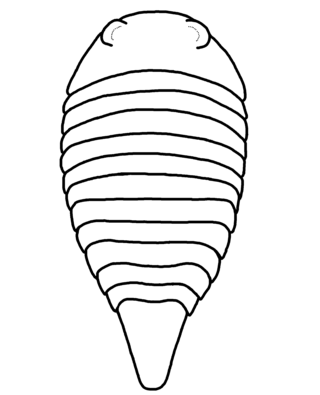
Paleomerus is a genus of strabopid, a group of extinct arthropods. It has been found in deposits from the Cambrian period. It is classified in the family Strabopidae of the monotypic order Strabopida. It contains two species, P. hamiltoni from Sweden and P. makowskii from Poland. The generic name is composed by the Ancient Greek words παλαιός (palaiós), meaning "ancient", and μέρος (méros), meaning "part".

Squamacula is an extinct artiopodan arthropod from the Cambrian Series 2. The type species S. clypeata was described in 1997 from the Chengjiang biota of Yunnan, China. At the time of description there were only two known specimens of S. clypeata, but now there are at least six known specimens. In 2012 a second species S. buckorum was described from the Emu Bay Shale of Australia.
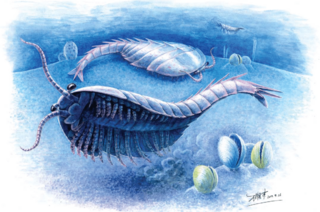
Fuxianhuiida is an extinct clade of arthropods from the Cambrian of China. All currently known species are from Cambrian Series 2 aged deposits in Yunnan Province, including the Chengjiang biota. Although historically suggested to be members of the arthropod stem group recent research has suggested that they may be closely related to mandibulates. Many specimens are known with exceptional soft tissue preservation, including preserved guts and neural tissue, which given their basal phylogenetic position makes them important in understanding the evolution of Arthropoda as a whole. They reach a size of up to 15 cm, and are interpreted as benthic predators and scavengers. The Fuxianhuiid exoskeleton is unmineralised, and the number of tergites ranges from 15 to over 40. The cephalon is covered by a head shield and contains stalked eyes connected by the anterior sclerite, antennae, a butterfly shaped hyposome and a posterior facing mouth. Fuxianhuiids possess specialized post-antennal appendages with serrated edges used for food processing. The presence of gnathobases in members of Chengjiangocardidae suggests that they were capable of durophagy. In most Fuxianhuiids, the thorax tergites narrow posteriorly, terminating in either a swimming paddle or paired flukes with a tail spine. In members of Fuxianhuiidae the thorax is divided into two sections, the anterior wide opisthothorax and the posterior narrow limbless tail-like abdomen.

Kylinxia is a genus of extinct arthropod described in 2020. It was described from six specimens discovered in Yu'anshan Formation in southern China. The specimens are assigned to one species Kylinxia zhangi. Dated to 518 million years, the fossils falls under the Cambrian period. Announcing the discovery on 4 November 2020 at a press conference, Zeng Han of the Nanjing Institute of Geology and Paleontology, said that the animal "bridges the evolutionary gap from Anomalocaris to true arthropods and forms a key ‘missing link’ in the origin of arthropods," which was "predicted by Darwin’s evolutionary theory." The same day the formal description was published in Nature.
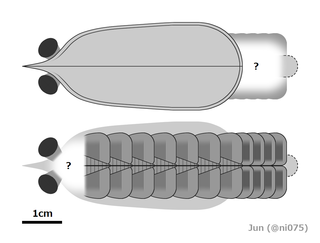
Erratus is an extinct genus of marine arthropod from the Cambrian of China. Its type and only species is Erratus sperare. Erratus is likely one of the most basal known arthropods, and its discovery has helped scientists understand the early evolution of arthropod trunk appendages. Some of the stem-arthropods like radiodonts did not have legs, instead they had flap like appendages that helped them swim. Erratus on the other hand had not only flaps but also a set of primitive legs. It also supported the theory that the gills of aquatic arthropods probably evolved into the wings and lungs of terrestrial arthropods later in the Paleozoic.
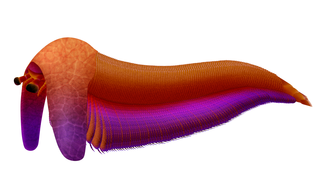
Balhuticaris is a genus of extinct bivalved hymenocarine arthropod that lived in the Cambrian aged Burgess Shale in what is now British Columbia around 506 million years ago. This extremely multisegmented arthropod is the largest member of the group, and it was even one of the largest animals of the Cambrian, with individuals reaching lengths of 245 mm (9 in). Fossils of this animal suggests that gigantism occurred in more groups of Arthropoda than had been previously thought. It also presents the possibility that bivalved arthropods were very diverse, and filled in a lot of ecological niches.
Bushizheia is an extinct genus of arthropods known from a single specimen found in the Early Cambrian Maotianshan Shales Lagerstätte in China. The genus contains a single species, Bushizheia yangi. While it had a superficially trilobite-like bodyform, it also possessed large frontal appendages similar to those of radiodonts. It is morphologically similar to Kiisortoqia to which it is probably closely related.

Apankura is an extinct genus of Cambrian euthycarcinoids from the Santa Rosita Formation of Argentina. The genus contains a single species, Apankura machu. It was at one point the only Cambrian euthycarcinoid. However, Mosineia and Mictomerus are likely older.
Cambropodus is a genus of Cambrian arthropod from the Wheeler Shale of Utah. It contains one species, Cambropodus gracilis.
















